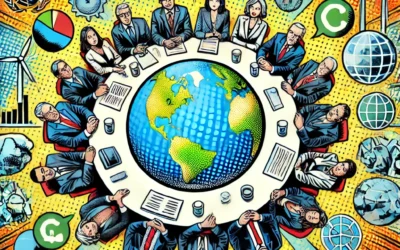What would happen if we stopped all carbon emissions today?
If we stopped all carbon emissions today, would we stop climate change? This is a question that many people wonder about, especially in the face of the Paris Agreement, which aims to limit the global warming to 1.5°C above pre-industrial levels.
The answer, however, is not so simple. Carbon emissions are not the only factor that affects the climate, and the climate system is not so easy to predict. In this article, we will explore what would happen if we stopped all carbon emissions today, and what are the implications for the future.
The role of carbon emissions in climate change
Carbon emissions are the main cause of global warming and climate change. They come from burning fossil fuels, such as coal, oil, and gas, for energy, transport, industry, and other activities.
Carbon emissions release carbon dioxide, which is the most abundant and long-lived greenhouse gas in the atmosphere. Greenhouse gases trap heat in the atmosphere and cause the greenhouse effect, which is the main driver of global warming and climate change.
According to the IPCC, the global average temperature has increased by about 1.1°C since the late 1800s, and it is projected to rise further if emissions are not reduced. The consequences of global warming are already evident and severe. They include more frequent and intense heat waves, droughts, floods, storms, and wildfires, which threaten lives, livelihoods, and infrastructure.
They also include changes in precipitation patterns, melting of glaciers and ice caps, sea level rise, ocean acidification, and loss of biodiversity and ecosystem services. These impacts are expected to worsen with higher levels of warming, and they pose significant risks to food security, water availability, health, peace, and development.
To avoid the worst-case scenarios, the IPCC has warned that global carbon emissions need to be reduced by 45% by 2030 and reach net zero by 2050, compared to 2010 levels. This would give the world a 50% chance of limiting the global warming to 1.5°C, and a 66% chance of limiting it to below 2°C. Achieving net zero by 2050 means that the amount of carbon dioxide emitted into the atmosphere is balanced by the amount removed, either by natural or artificial means.
The effects of stopping all carbon emissions today
What would happen if we stopped all carbon emissions today? This is a hypothetical scenario that is unlikely to happen, but it can help us understand the dynamics of the climate system and the inertia of the carbon cycle.
The answer, however, is not straightforward, as it depends on many factors, such as the feedbacks and uncertainties in the climate system, the interactions and lifetimes of different greenhouse gases, and the natural and human-induced sinks and sources of carbon.
One way to approach this question is to use climate models, which are mathematical representations of the physical and chemical processes that govern the climate system. Climate models can simulate different scenarios of future emissions and their impacts on the climate. One such scenario is the zero emissions commitment (ZEC), which assumes that all anthropogenic emissions of carbon dioxide and other greenhouse gases are stopped at a certain point in time.
According to a recent study published in Nature Climate Change, the ZEC scenario shows that if we stopped all carbon emissions today, the global average temperature would still increase by 0.2°C over the next 10 to 20 years, before stabilizing or slightly declining. This is because carbon dioxide is not the only greenhouse gas that affects the climate, and some of them have a cooling effect.
For example, sulfur dioxide, which is emitted from coal-fired power plants and diesel-fueled vehicles, forms aerosols that reflect sunlight and cool the Earth. If we stopped these emissions, the cooling effect would be lost, and the temperature would rise temporarily.
However, the ZEC scenario also shows that if we stopped all carbon emissions today, the global average temperature would not exceed the 1.5°C threshold, and it would have a 42% chance of staying below it. This is because carbon dioxide is the most abundant and long-lived greenhouse gas in the atmosphere, and it has a strong warming effect. If we stopped emitting carbon dioxide, the concentration of this gas in the atmosphere would start to decline, as it would be absorbed by the oceans and the land. This would reduce the greenhouse effect and the warming of the Earth.
The ZEC scenario, however, does not account for other factors that could affect the climate, such as the feedbacks and uncertainties in the climate system, the interactions and lifetimes of different greenhouse gases, and the natural and human-induced sinks and sources of carbon.
For example, the ZEC scenario does not consider the possibility of tipping points, which are thresholds that, once crossed, can trigger irreversible and large-scale changes in the climate system. One such tipping point is the release of carbon dioxide and methane from thawing permafrost, which could amplify the warming and make it harder to reverse. Another such tipping point is the collapse of the West Antarctic ice sheet, which could raise the sea level by several meters and displace millions of people.
The ZEC scenario also does not consider the possibility of negative emissions, which are technologies and practices that can remove carbon dioxide from the atmosphere and store it permanently. Some examples of negative emissions are afforestation, bioenergy with carbon capture and storage, and direct air capture. Negative emissions could help reduce the concentration of carbon dioxide in the atmosphere and lower the temperature, but they also face technical, economic, and social challenges.
The implications for the future
The ZEC scenario shows that if we stopped all carbon emissions today, we could still limit the global warming to 1.5°C, but it also shows that this is not enough to stop climate change. Climate change is not only caused by carbon emissions, but also by other greenhouse gases, aerosols, and natural variability.
Climate change is also not only measured by temperature, but also by other indicators, such as precipitation, sea level, and extreme events. Climate change is also not only a future problem, but also a present reality, as we are already experiencing its impacts on human health, ecosystems, and the economy.
Therefore, stopping all carbon emissions today is not a realistic or sufficient solution to climate change. We need to take a more comprehensive and long-term approach, that considers not only carbon emissions, but also other greenhouse gases, aerosols, and natural variability. We need to not only reduce emissions, but also enhance sinks, adapt to impacts, and support resilience. We need to not only act today, but also plan for tomorrow, and prepare for the unexpected.
Conclusion
If we stopped all carbon emissions today, would we stop climate change? The answer is no, but we could still limit the global warming to 1.5°C, which is the goal of the Paris Agreement. However, this would require not only stopping all carbon emissions, but also accounting for other factors that affect the climate, such as other greenhouse gases, aerosols, and natural variability.
It would also require not only limiting the global warming, but also addressing the other aspects and impacts of climate change, such as precipitation, sea level, and extreme events. It would also require not only acting today, but also planning for tomorrow, and preparing for the unexpected.
Stopping all carbon emissions today is not a realistic or sufficient solution to climate change. We need to take a more comprehensive and long-term approach, that considers the whole climate system and the whole human society.
Learn more:






